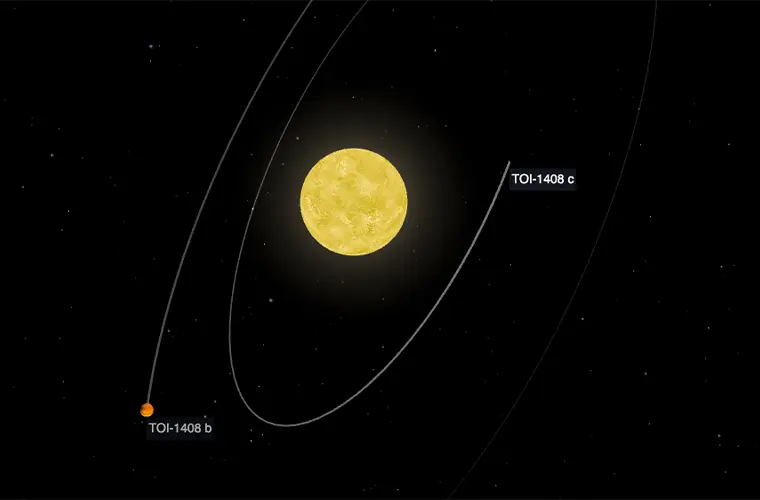In a discovery that could reshape our understanding of planetary dynamics, astronomers at Lund University in Sweden have recently identified a mysterious exoplanet exhibiting an unusual orbit that defies conventional astrophysical theories.
The exoplanet, named TOI-1408c, is located in a distant star system about 455 light-years from Earth and follows a perplexing, erratic orbital path that has baffled researchers.
“The small planet exhibits very unusual orbital behavior and shows considerable variations regarding the time when it passes in front of its star, which is something that we don’t see as a rule,” Dr. Judith Korth, astrophysicist at Lund University and lead study author, said in a press release. “The small planet’s existence challenges existing theories on the formation and stability of planetary systems.”
TOI-1408c is just over two times the size and nearly eight times the mass of Earth. Discovered in 2024 using data captured by NASA’s Transiting Exoplanet Survey Satellite (TESS), the exoplanet is close to a much larger “hot Jupiter” planet, “TOI-1408b” and the hot gas giant TOI-1408.
TOI-1408c peculiarities became evident almost immediately after its detection. While most planets follow relatively predictable elliptical orbits around their host stars, the exoplanet’s path is erratic, shifting direction unexpectedly.
Findings recently published in the Astrophysical Journal Letters detail how the mysterious exoplanet has an orbital motion that seems to wobble and change speed unpredictably. Unlike the steady paths traced by the planets in our own solar system, researchers likened TOI-1408c’s orbital behavior to a “rhythmic dance.”
The discovery of TOI-1408c’s bizarre movement and location between a star and gas giant have prompted scientists to question some of the core principles of planetary dynamics.
“The existence of a small inner planet in such a tight orbit around a hot Jupiter adds a valuable data point against the backdrop of current planet formation theories, challenging the typical scenarios suggested for close-in giant planets,” researchers wrote.
Several theories could explain the bizarre movement of TOI-1408c. One possibility is that the mysterious exoplanet is being influenced by an unseen celestial body, such as a rogue planet or a small, dense object like a neutron star. This hypothetical object could exert a gravitational force on TOI-1408c, causing its erratic movements.
Another theory could be that TOI-1408 c experienced a massive collision with another celestial object in the past. This impact could have thrown it off its original orbit, resulting in its unpredictable trajectory.
Recently, citizen scientists discovered a mysterious object blazing through the outer solar system at 1 million miles per hour. The exact nature of the object remains unknown. However, one theory is that it is a “rogue planet” ejected from its original star system.
Although this does not explain TOI-1408c’s strange behavior, the presence of “rogue planets,” which could potentially move at 0.149% of the speed of light, highlights how the universe can often be violently unpredictable.
The discovery of TOI-1408c’s strange orbit might seem like a narrow focus in the grand scheme of space exploration. However, its implications could be far-reaching. If researchers can pinpoint the reasons behind this mysterious exoplanet’s odd behavior, it could lead to new insights into the formation and evolution of planetary systems.
Moreover, the discovery comes when astronomers are increasingly focusing on exoplanets in the search for extraterrestrial life. Understanding how and why planets behave differently from those in our solar system could help scientists identify other potentially habitable worlds.
Researchers hope their findings and discovery of TOI-1408 c’s unprecedented movement will advance our understanding of the universe.
“Our results will help researchers to learn more about how planets are formed and how they behave when they are very close to each other, particularly in systems with giant planets,” Dr. Korth said.
For now, TOI-1408 c remains an enigma and celestial puzzle waiting to be solved. Its strange orbit challenges our understanding of how planetary systems operate and offers a tantalizing glimpse into the complexity of our universe.
As researchers concluded, “This research not only deepens our understanding of multiplanet systems involving hot Jupiters with inner low-mass companions but also underscores the need for continued exploration to uncover the diverse architectures of exoplanetary systems.”
Tim McMillan is a retired law enforcement executive, investigative reporter and co-founder of The Debrief. His writing typically focuses on defense, national security, the Intelligence Community and topics related to psychology. You can follow Tim on Twitter: @LtTimMcMillan. Tim can be reached by email: tim@thedebrief.org or through encrypted email: LtTimMcMillan@protonmail.com

